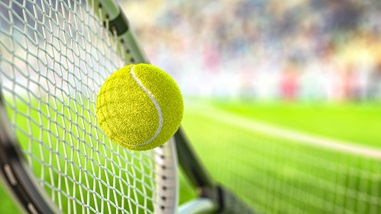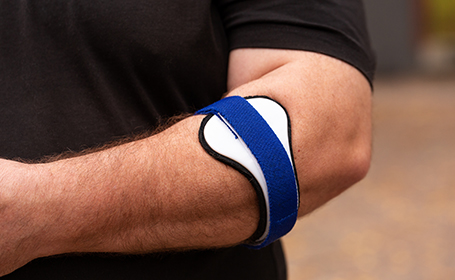
Tennis elbow advice
You don't have to smash serves like Serena to fall foul to Tennis Elbow: you don't even have to play tennis. But if you do enjoy a regular set or two, or do anything that causes strenuous and repetitive use of the muscles and tendons around the elbow joint, you're at risk of developing this tell-tale pain that could keep you off-court for some time and make some everyday activities a struggle.
Corticosteroids, Shockwave therapy and surgery are all treatment options, but physiotherapy and rest are the most common ways of managing the problem.
Resting the joint allows it to repair itself, but this can take months, or even longer, because tendons heal slowly. If you don't want to be off the court for that long, try these five simple exercises to help ease pain and prevent further injury or speak to a specialist sports injury physiotherapist for more advice.
Physiotherapy and rest are the most common ways of managing the problem.
1. Wrist turn
Build up strength with or without weights. Hold your arm at a right angle and open your hand, palm up. Slowly turn your wrist so your palm faces down, hold for five seconds then return. Repeat for 10 turns and do the same on the other arm. You can increase resistance by using a weight, such as a dumbbell, tin can or filled water bottle, in your hand.
2. Sock it to them
Hold a tennis ball (or a rolled-up sock) in your hand. Squeeze and hold for around five or six seconds, then relax. Repeat ten times and then switch to your other hand and start again to increase the strength of your forearm muscles.
3. Shake it out
Place your arm on a flat surface, such as a table, with your hand hanging off the end. Imagine you are shaking hands with someone and move your hand up and down 10 times. Switch arms then repeat on both sides again.

4. Circles
Place your forearm on your thigh with your hand extending over your knee, palm up. Hold your hand in a light fist and make slow circles with your hand. Repeat 20 times then start again with the other arm.
5. Stretch
Extend your arm in front of you with your palm facing up then bend your wrist so your hand points towards the floor. Then use your other hand to very gently bend the wrist further. Hold for up to 30 seconds as you feel a medium stretch to your forearm and repeat up to four times. Repeat with your other arm then start again with your palm facing down.
Warm up and cool down every time
Tennis Pre-match warm up exercises can help you to avoid injury by increasing blood flow to the muscles and making them more supple and ready to withstand the stresses your game will place on them. But that doesn't mean just a couple of practice hits before the match.
When you watch Serena and the elite enter the courts at Wimbledon to do their warm up before the game, what you don't see is that they have already spent a considerable time stretching, loosening and preparing their entire body before heading out to the court.
At the end of the game carry on at a lower intensity for around five to ten minutes, or walk, jog or cycle, to allow your heart rate to return to normal gradually and to help to remove metabolites, such as lactic acid, from the muscles. Stretching post-game can also help maintain flexibility and will prepare your muscles for your next match.
Take the time to build up the muscle strength you need to support it and help prevent injury or speed-up recovery.
Play to your strengths

Whatever level you play at, strains to the elbow can abruptly bring your court action to a halt: Serena herself had to pull out of the Italian Open last month thanks to a problem with her elbow which was affecting her mighty serve.
Whilst you might never reach a serve speed even close to the dizzying heights of Serena, or have to return a ball travelling at over 125mph, whatever forces you are subjecting your elbow to, take the time to build up the muscle strength you need to support it and help prevent injury or speed-up recovery.
If you have an injury always consult a specialist before carrying out any exercises. At Circle Health Group's Sports Injury Clinics you'll find all the expertise you need to keep you on the court at optimum fitness. As well as treating any injury, we will evaluate the underlying causes to help prevent future problems. We'll plan the best warm up and muscle training exercises for you and if you need further treatment, we can facilitate a fast referral to an orthopaedic surgeon.
Tags
How do I book an appointment?
If you're concerned about symptoms you're experiencing or require further information on this subject, talk to a GP or see an expert consultant at your local Circle Hospital.